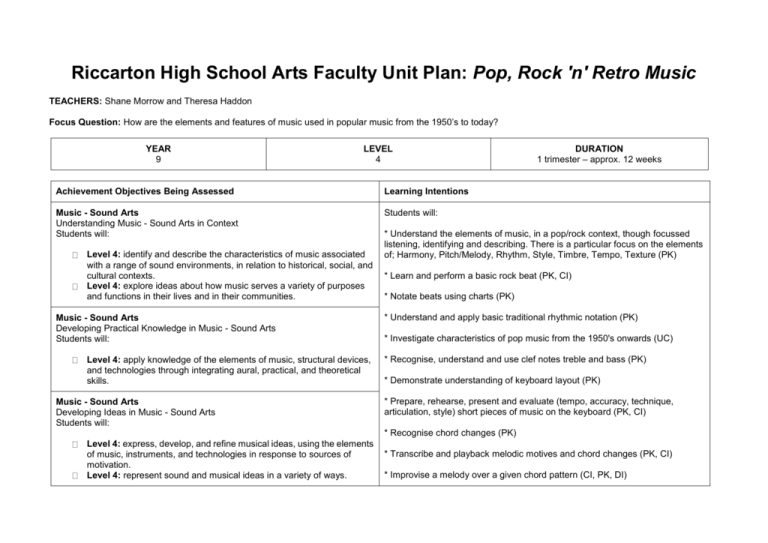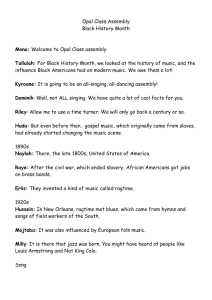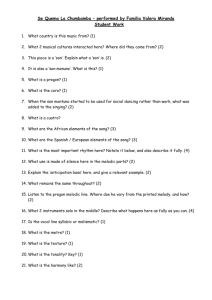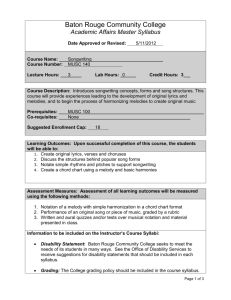PopRocknRetroUnitPlan20101 - Arts Online
advertisement

Riccarton High School Arts Faculty Unit Plan: Pop, Rock 'n' Retro Music TEACHERS: Shane Morrow and Theresa Haddon Focus Question: How are the elements and features of music used in popular music from the 1950’s to today? YEAR 9 LEVEL 4 Achievement Objectives Being Assessed Learning Intentions Music - Sound Arts Understanding Music - Sound Arts in Context Students will: Students will: Level 4: identify and describe the characteristics of music associated with a range of sound environments, in relation to historical, social, and cultural contexts. Level 4: explore ideas about how music serves a variety of purposes and functions in their lives and in their communities. Music - Sound Arts Developing Practical Knowledge in Music - Sound Arts Students will: Level 4: apply knowledge of the elements of music, structural devices, and technologies through integrating aural, practical, and theoretical skills. Music - Sound Arts Developing Ideas in Music - Sound Arts Students will: DURATION 1 trimester – approx. 12 weeks * Understand the elements of music, in a pop/rock context, though focussed listening, identifying and describing. There is a particular focus on the elements of; Harmony, Pitch/Melody, Rhythm, Style, Timbre, Tempo, Texture (PK) * Learn and perform a basic rock beat (PK, CI) * Notate beats using charts (PK) * Understand and apply basic traditional rhythmic notation (PK) * Investigate characteristics of pop music from the 1950's onwards (UC) * Recognise, understand and use clef notes treble and bass (PK) * Demonstrate understanding of keyboard layout (PK) * Prepare, rehearse, present and evaluate (tempo, accuracy, technique, articulation, style) short pieces of music on the keyboard (PK, CI) * Recognise chord changes (PK) Level 4: express, develop, and refine musical ideas, using the elements of music, instruments, and technologies in response to sources of motivation. Level 4: represent sound and musical ideas in a variety of ways. * Transcribe and playback melodic motives and chord changes (PK, CI) * Improvise a melody over a given chord pattern (CI, PK, DI) Music - Sound Arts Communicating and Interpreting in Music - Sound Arts Students will: Level 4: prepare, rehearse, and present performance of music, using performance skills and techniques. Level 4: reflect on the expressive qualities of their own and others music, both live and recorded. * Compose an original song chorus (UC, PK, DI, CI) * Identify what makes a good song using specific terminology- e.g bridge, chorus ( UC, CI) *Demonstrate understanding of song structure through identifying key aspectse.g hook, chorus, verse etc ( UC, PK, CI) KEY COMPETENCIES Reflective Questions: Thinking Using language, symbols, and texts Blooms Revised Taxonomy is explicitly woven into the learning activities in music. Students move from lower order thinking skills (remembering, understanding and applying) to higher order thinking skills (analysing, evaluating, creating) as the course progresses and they gain practical knowledge in music. Students have opportunities to use their higher-order thinking skills through playing and performing other people’s music and through creating and composing their own music. Music requires on-going literacy skills as students learn and correctly use vocabulary, respond in writing to pieces of music they hear and play. Students also learn, use, apply and understand traditional music stave notation symbols. Managing self Students set their own goals and challenge themselves as they work at their own pace in practical activities. Managing self also means the ability to be self-disciplining in performance activities. Self-assessment and reflection are a key part of this course Relating to others Cooperation is an integral part of group music making. Students will develop their active listening skills. Participating and contributing Students are taught to contribute appropriately in music performance groups and in collaborative tasks. Can you solve the problem yourself? Do you ask questions to find out more? How can you perform better? How can your music sound better? Do you apply knowledge from other situations? What do you want to achieve? How will you achieve it? How do you get your message across? How can you express yourself with music? In what ways can you communicate your music to others? How can you share information with others? How can you research new information? Do you have everything you need to learn? What are your goals and what steps do you need to take? What stops you learning and what can you do about it? What help do you need and where can you get it? How do you manage your time to meet deadlines? What do you need to do at home to be successful in class? Do you listen to what others have to say? Can you negotiate and compromise? Can you get your point across clearly? How do you help to find a solution? Do you share your ideas, compositions, and skills? What do you do to make the class, or your group, successful? Do you turn up to all your group rehearsals? Are you using the opportunities available to extend your skills? What do you do if you are unsure of the task requirements? How can you be more involved in the lesson? TEACHER BACKGROUND READING Assessing in the Arts http://nces.ed.gov/nationsreportcard/arts/whatmeasure.asp Does Your Assessment Support Your Students' Learning? (PDF) http://arts.unitec.ac.nz/documents/GrahamGibbAssessmentLearning.pdf Learning Through the Arts http://www.learningthroughart.org/research_findings.php Technology as arts-based education: Does the desktop reflect the arts? (PDF) http://www.cust.educ.ubc.ca/faculty/facpages/goudownload/VAR.pdf Strategies for Success: Engaging Students in Secondary Schools http://www.cal.org/resources/digest/0003strategies.html LEARNING SEQUENCE Teaching and Learning Experiences *Literacy strategies in red text Resources Watch Give It A Whirl – Fifty Years of Popular Music History. Students answer focus questions in small groups: What has changed? What makes you laugh? List the songs you recognise. In groups complete Picture Jigsaw of table from pg 17 of Sweet matching definition with elements (Pitch, Tempo, Harmony, Texture, Timbre). Fill in table with same definitions in workbook. Names of elements missing; students have to match elements to given definitions. Use red and yellow “Elements” cards to match definitions as revision Describe elements of Eight Days a Week while listening. Beatles ppt and Lucy in the Sky with Diamonds listening sheet – cloze of lyrics Elements cards and ppt Beatles ppt Lucy in the Sky with Diamonds task sheet (Jazz and Rock Resource) Learn parts of drum kit and basic rock beat (bass, snare, hi-hat) to play along with Eight Days a Week students complete number chart Learn standard rhythmic notation using Graphic Organiser Rhythm Tree (semibreves, minims, crotchets, quavers, notes/rest, time sig.) , Students make own organiser then convert their number grids to standard rhythmic notation. Teaching Popular Music pg 43 Number grids Teaching Popular Music pg85 Give It A Whirl DVD One Day – Opshop puzzle Eight Days a Week – Beatles Elements table adapted from Sweet Ongoing Assessment Approaches Teacher observation Theory Matters worksheet 2 (PK). Differentiated learning; students complete either worksheet 2a (beginners) or 2b (approx curriculum level 4) or 2c (most challenging) Play Eight Days a Week on Keyboard Learn treble and bass clef notes, do Story Notes sheet as practice (missing words of story are spelt out using pitch notation; students work out names of notes to spell missing words) Listening activity on Can’t Help Falling In Love to reinforce elements and features, work out and notate basic beats. Use chart; students tick if feature is present in song. Small homework Writing Frame activity to summarise comparisons. “Making Comparisons” from Music Matters pg 12 Listen to Those Magic Changes from Grease. Identify and play ‘Ice Cream Changes’ (C, a min, F, G) Listen to Lonely by Akon. Work out chords (C, emin, F, G) Listen to Superman; It’s Not Easy and work out chord progression (C, G, amin, F) Perform Superman; It’s Not Easy as a whole class from written notation. Ice Cream Changes ppt Chords written out for easy fingering on keyboard. Class arrangement of Superman Learn sharp, flat, natural, tones and semitones Complete melodic fragment from introduction of Renegade Fighter Use Renegade Fighter handout from Sweet. Students do ‘treasure hunt’ to find and label: time sig, a sharp, natural, repeat mark, tie, a minor chord, a 7th chord, a key sig. Work out chord changes for verse, notate them onto Cloze template of lyrics, and play along with the recording. Listening activity 3 versions of Time After Time to revise and reinforce elements and features. Use chart; students tick if feature is present in song. Play melody (and chords) on keyboard Listen to Rock Around the Clock or Jailhouse Rock hearing the 12 bar blues changes. What is 12 Bar Blues? Characteristics of blues Revise triads and 7th chords Perform class arrangement of Rock Around the Clock Hands On Piano Book 1, keyboard lab Story Notes Sheet Theory Matters Theory Matters worksheet 1 (PK). Differentiated; students do one of 1a or 1b or 1c. Formative group performance. (PK, CI) Renegade Fighter – Zed from Sweet pg 37 Nature’s Best DVD has the music video of Renegade Fighter Chord recognition reinforcer More Aspects of Music p.65 Time After Time task sheet Recordings of Cyndi Lauper, Tuck and Patti, Quietdrive CD and class arrangement of Rock Around the Clock Second group performance opportunity. (PK. CI) Listen to some blues and, in pairs, brainstorm characteristics to identify common elements and features: sad mood, slow tempo, instrumentation, 3 melodic phrases, rhyme pattern, 12 bar blues chord pattern Build up a list of characteristics of blues music. Into Music 3 – p.52 & backing CD. Essential Jazz CD: Bessie Smith Mean Old Bed Bug Blues , Ella Fitzgerald Any Old Blues, Aretha Franklin Blue By Myself, Sweet Lover. BB King: Questionnaire Blues, Other Night Blues Simpsons Sing the Blues Improvise on keyboard over Am7 chord with swing backing. Practice and perform to class Other half of class does Story Notes sheet, Bird Cage Café, including bass clef as reinforcer then swap over. Homework: Note Puzzle 1 (Bass clef) Compose two–bar melodic phrases to complete given openings Perform in groups using piano or guitar accompaniment Answering the Question task sheet Song writing Brainstorm elements of a song, what it needs in it. Listen to Use Somebody. Identify three features of the song that make it a good song e.g- hook, verse, chorus. In groups of three come up with a 30 second chorus to a song that uses the song writing features. Perform the song, assess and evaluate. What makes a good song- task sheet What is a hook- ppt What is an effective melody-ppt Select, prepare, rehearse, present a piece of music for solo performance on keyboard or own instrument Students can choose a piece that has been worked on in class or make own choice Listen to Only Wanna Be With You. General impression on first listening, use melody jigsaw puzzle and then follow score while listening to check. Noodlin’ on Am7 sheets Story Notes Bird Cage Café or Grandpa’s Farm or Abe’s Big Night Note Puzzle 1 Solo performance assessment (PK, CI) Hands on Piano Class orchestra arrangements Other sheet music Into Music 3 Dusty Springfied CD Self assessment sheet (PK, CI) Work stations of the parts, playing along with recording. Select part to practice, rehearse, perform and evaluate Class orch. Arrangement, workstation cards and melody jigsaws In groups complete History of Pop flowchart of styles History of Pop ppt ASSESSMENT Group Performance Assessment (Teacher): evidence towards Playing and Performing report grade Achievement Merit Perform generally accurate music, showing some control and appropriate group listening skills. Perform mostly accurate music, showing control and effective group listening skills. Excellence Confidently perform very accurate music, showing a high level of musical and group listening skills. Group Performance Preparation (Self Assessment): Self assessment part 1 I did not co-operate well within my group. I co-operated well within my group. I co-operated very well within my group, helped us to get the piece together. I co-operated fully within my group, helped us to get the piece together, perhaps by taking some leadership role. I rehearsed my part well enough so that I could play it mostly accurately. I rehearsed my part well so that I could play it mostly accurately. I rehearsed my part effectively so that I could play it accurately. Self assessment part 2 I rehearsed my part but still could not play it very accurately. Solo Performance Assessment (Teacher): evidence towards Playing and Performing report grade Achievement Perform generally accurate music, showing some control and appropriate musicianship. Merit Perform mostly accurate music, showing control and effective musicianship. Excellence Confidently perform very accurate music, showing convincing musicianship. Answering the Question Compositions: evidence towards Creating and Composing report grade Achievement Composes pieces using the given notes which show fundamental understanding of balanced musical phrasing, style, and melodic shape. There is some accuracy in the notation of the pieces. Merit Composes effective pieces using the given notes which show understanding of balanced musical phrasing, style, and melodic shape. The pieces are notated mostly accurately. Excellence Composes convincing pieces using the given notes which show clear understanding of balanced musical phrasing, style, and melodic shape. The pieces are notated accurately. Song Writing Task: evidence towards Creating and Composing report grade Achievement Composes a song in a group which shows fundamental knowledge of song structure, melody, and chord progressions. Merit Composes an effective song in a group which shows understanding of song structure, melody, and chord progressions. Excellence Composes a convincing song in a group which shows clear understanding of song structure, melody and chord progressions. Listening Test: evidence towards Listening and Reading report grade Achievement Identify the use of elements and features in pop, rock ‘n’ retro music. Provide personal reactions. Merit Identify and describe the use of elements and features in pop, rock ‘n’ retro music. Provide personal reactions. Music Reading Test: evidence towards Listening and Reading report grade Excellence Identify, describe, and evaluate the use of elements and features in pop, rock ‘n’ retro music. Provide and justify personal reactions. Achievement Demonstrate understanding of music notation through generally accurate identification, description and explanation. Merit Excellence Demonstrate understanding of music notation through mostly accurate identification, description and explanation. Demonstrate understanding of music notation through highly accurate identification, description and explanation. RESOURCES Print Title The Jazz and Rock Resource Author(s) Lowe Pop Music the Text Book Pop Music the Q and A Book Winterson, Nikol, Bricheno Winterson, Nikol, Bricheno In Tune With Music Book 2 In Tune With Music Book 3 Aspects of Music Dorricott and Allan Dorricott and Allan Hodge, Pollock, Dunbar-Hall Reading and Writing Rock Teaching Popular Music About Music 3rd Ed. Presto 1 Presto 2 Composing Matters Offbeat - A Practical Guide to Pop and Jazz for GCSE Listen, Compose, Perform The Rock Book Sweet, Sweet 2 Songwriting for Beginners Brown, Dillon, Purcell Dunbar-Hall Hutchinson Blyth Blyth Allen Crozier Winters Lowe Learning Media Davidson and Heartwood Specific References Chapters 15 to 19 CD ROM worksheet 19.6 Ch 11 Song structure Listening questions p.39 blues style and structure from p. 199 Pop song characteristics Unit 5 Rock ch 34 treble clef, 38 notes on stave Ch 50 Beatles?? p.75 syncopation sheet (link to Zed) p. 154 and 192 Theory Tests project 25 – good aural stuff on rock P.145 binary form project 1, project 9 p. 74 Writing a Pop Song p.83 Words and Music p.243 Writing Your Own Song DVD Making Music DVD (especially: Fat Freddy’s Drop, Feelers), Give It A Whirl, Stomp Out Loud Electronic Teacher Resource Exchange - Song Writing Unit http://arts.unitec.ac.nz/resource-exchange/view_resource.php?res=57 The Arts Exemplars http://www.tki.org.nz/r/assessment/exemplars/arts/index_e.php www.youtube.com Review: to be reviewed annually





